For William N. Lipscomb, Jr. by his son, James S. Lipscomb
William Lipscomb, University of Kentucky, senior year, 1941
(2 years before the Swingle Accident and 4 years before the Eldest Son -- stories below)
December 9, 1919 - April 14, 2011
Bill Lipscomb's eldest son was born Oct. 8, 1945. He rests in Calvary Cemetery in Los Angeles, having lived two hours.[BLipscomb1945] I speak in his name, though he had none. I am James, the younger brother.
Reference
[BLipscomb1945] Baby Lipscomb, Baby Grave 20, Lot 400, Section B, Calvary Cemetery, 4201 Whittier Blvd., Los Angeles, California, Oct. 8, 1945.
2. Swingle Accident
Elizabeth Mary Carter Swingle
When I feel proud of Bill, I am most often thinking of what he did on September 23, 1943, shortly after 1:00 p.m.
At the California Institute of Technology in the Crellin Laboratory's sub-basement twenty-nine year old Elizabeth Swingle waited for the elevator. In her hand a one kilogram bottle of ethyl chlorocarbonate blew off its cap, spraying liquid over her head and shoulders. [Pauling1943a] [Pauling1943b] Bill continues the story:
"I was down the hall, and I got her and put her in the shower. I was too late . She had already inhaled enough of it. I was the one who got the next largest dose as I stood there holding the shower. I couldn't get away. ... half the molecule is phosgene, so it does the same thing as phosgene. It gives HCl, hydrocholoric acid, in your lungs." [Lipscomb1991]
Phosgene dissolves in water producing hydrochloric acid, which kills lung tissue in the lower airway. Then, phosgene attacks the capillaries causing fluid to leak into the lungs, which, combined with tissue swelling in an inflammatory cascade, can cause drowning. [emedicine.medscape.com]
About eight hours later, Elizabeth Swingle died [Swingle1943].
Bill's lung function after was good enough for him to play tennis and the clarinet. He would cough terribly from the slightest cigarette smoke or vehicle exhaust. Bill's father's cigar smoking was a second possible source of Bill's sensitivity. Bill never spoke about the cause of his pulmonary problems or mentioned them in the context of the Swingle accident.
Chemistry killed Elizabeth Swingle, which Linus Pauling addressed in a paragraph of his talk at Memorial Services for Elizabeth Swingle:
"My friends, while we are thinking about Elizabeth, about her beautiful, friendly spirit, we may well ask why, why was she taken away from us suddenly, without warning, while going happily about her work. I think that we can find the answer to this question by contemplating the wonders of the world in which we live -- the wonderful order which underlies all natural phenomena. No one can study deeply the physical world without experiencing again and again a feeling of amazement, of transcendent exaltation, at the beautiful intricacy of the structures which constitute the physical world and the order of the laws which determine its course; and this feeling becomes ever stronger as we turn our attention to life, to man himself, and begin to understand, even though dimly, the almost unbelievably complex mechanisms of the physiological processes upon which life depends. Our faith in the future rests upon our faith in these laws of nature. And so we can understand that these laws cannot be broken, but must pursue their inexorable course even when, because of an accidental, unavoidable concatenation of circumstances, this course is such as to take from us our friend Elizabeth early in her life, while her spirit was still growing, her large circle of friends still expanding, her due cycle of life's rich experiences only to the midpoint traversed." [Pauling1943c]
References
Picture courtesy of MyHeritage.com.
[Pauling1943a] Pauling's real-time account of the Swingle accident in his notebook, Sept. 23-24, 1943.
[Pauling1943b] Pauling's letter to Eastman Kodak Company, Oct. 1, 1943. Technical description of the Swingle accident.
[Lipscomb1991] Elizabeth Swingle's Laboratory Accident, Audio clip of interview of William Lipscomb, Nov. 3, 1991, by Thomas Hager for use in "Force of Nature: The Life of Linus Pauling," (Simon & Schuster, 1995), 1 min. 33 sec.
[emedicine.medscape.com] Phosgene Toxicity.
[Swingle1943] Elizabeth Swingle's headstone, memorial, and relations at findagrave.com and at ancestry.com.
[Pauling1943c] Pauling's Talk at Memorial Services for Elizabeth Swingle, page 1, page 2. Sept. 27, 1943.
3. Next Generation
An old person may pull the child aside to pass along the important. I received four such lectures, herewith passed on as gifts from Bill to the next generation of scientists.
- What Bill told me most separates him from the other high-performers is that he picked those grand challenges that might be impossible but that could be broken down into a stepwise path. In this way the highest step that one can climb will give the biggest accomplishment possible. Bill later crystallized the point:
"I have failed at everything [big] I've tried, but I set intermediate goals."
There is a fuller account here.
- Even now in the 21st century the nature of the chemical bond is in some ways little understood. We do not have
"... a systematic valence description of the vast numbers of 'electron deficient' intermetallic compounds," [Lipscomb1977b]This is what Bill had planned to pursue after understanding boron bonding. That is, we do not fully understand of the nature of the chemical bond in for example KHg13 and Cu5Zn7 in that we cannot predict many such structures. Bill concludes:
"For the person who figures this out there may be a big prize."
There is a fuller account here.
- Bill's research group showed how the three-center two-electron bond works through electron orbital calculations not using something new, but using existing formulas by Edmiston and Ruedenberg [Edmiston1963], and by Boys [Boys1966] that as Bill said:
"... when you plug [the situation] into it, gives you the three-center bond, whether you are looking for it or not."
and
"Anyone could have done it."
There is a fuller account here.On today's occasion there may be lists by which we might know Bill, lists of Lipscomb this and Lipscomb that. But Bill's list above of what his son must know looks outward:
- The Bohr radius and the Rydberg constant of the hydrogen atom can be derived from first principles. Bill showed the derivations on one page.
- Advice on how to choose and to attack big scientific challenges;
- A career suggestion of a big chemistry challenge;
- High credit to key contributors;
- The beauty of simplicity and elegance in nature.
References
[Lipscomb1977b] Lipscomb WN. 1977. The Boranes and Their Relatives. in Les Prix Nobel en 1976. Imprimerie Royal PA Norstedt & Soner, Stockholm. 110-131. Quote in the next to last paragraph omitted from the Science magazine version of the paper. See page 242 of the nobelprize.org pdf.
[Edmiston1963] Edmiston CK. Ruedenberg K. 1963. Localized Atomic and Molecular Orbitals. Rev. Mod. Phys. 35, 457-465.
[Boys1966] Boys SF. 1966. Quantum Theory of Atoms, Molecules and the Solid State. (P. 0. L\F6wdin, Ed.). Academic Press, New York. 253-262.
4. Friends
Bill had many quiet friends whom he heard from when there was an occasion. But close friends we shall always hear from - never so many of those.
Bill kept an emotional distance. Marydell, Bill's first wife, was a gifted conversationalist who freely spoke her heart to all. Bill told her,
"You must never do that. They will get a handle on you."
These two spirits would never understand each other.
When Bill could no longer work in his advanced old age, his days were spent at home. Among my visits I recall the phone ringing to bring the voice of a friend four times.
Sometimes I would drive Bill to the Harvard mailroom. There were many magazines.
5. Forgiveness
Forgiveness is not something that one can give to oneself.
Forgiveness to the son
I was in secondary school. Bill came to my room. It was time to speak to the son with the mediocre grades. Bill spoke of how the Lipscomb male line had produced four generations in a row of doctors of one sort or another, M.D. or Ph.D. He said that logically it could not go on forever. It must end sometime. Then he left.
Bill did not give up on me. He later sent me to a private high school whose tuition he could scarcely afford. Perhaps by way of reply I eventually was awarded a Ph.D. I wonder if Bill was proud of me in this regard. We never spoke of it.
But for now in his young son's room we did not see this future. Bill had stopped talking. Bill gives the surface facts, leaving it the listener to read his heart. To my reading the conclusion was self evident. Bill was letting go of a dream that his son would be the fifth doctor in a row. Bill was giving in advance forgiveness to me.
Forgiveness to the father
Biographers beware of the drive-by interview. Over time, complexity and ambiguity may emerge.
Bill's father was a physician, as was Bill's grandfather and great grandfather. Bill's father, William Lipscomb Sr., died three years before his son was awarded the Nobel Prize.
There was a day when Bill Lipscomb spoke wistfully,
"I was told jokingly that if I were to be a physician I would be the fourth straight generation."
And there were more of these days when Bill spoke of how his physician father told Bill that he should do whatever he wanted, that his father was content with Bill's choice to get a Ph.D. rather than an M.D.
But, there was another day. My records suggest that it was in 2008:
"I have one regret about the Nobel Prize. I regret that it did not happen a few years earlier. If it had, then maybe my father would have forgiven me."
Lingering doubts from the heart. Bill had just done what he had told Marydell one must never do.
After some thought, I replied, not as the son. I spoke as the grandson of the medical doctor. I am by some accounting 1/4 my grandfather.
I told Bill that like the early anatomists who pioneered dissection to see the structure and then to deduce how the body works, so too Bill's research group was among the first, just after the solutions of myoglobin and lysozyme,[1] to find the atomic structure of two large proteins and to deduce how they work, carboxypeptidase A and aspartate carbamoyltransferase, each the largest structure in its time and together pioneering 20th century dissections.
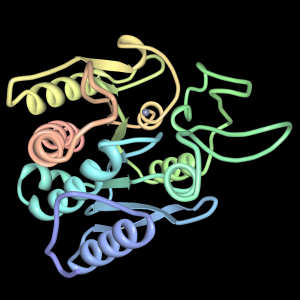
carboxypeptidase A [Lipscomb1968]
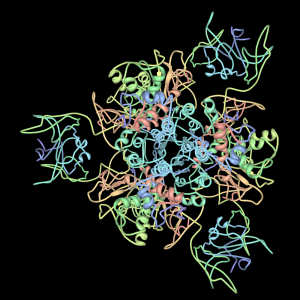
aspartate carbamoyltransferase [Honzatko1983]
I said that the earliest anatomists had no medical degrees. There was no such thing then, but now the medical community counts them as fully their own.
I further spoke of how Bill's recent work on fructose-1,6-bisphosphatase and its inhibitor MB06322 (CS-917) with Metabasis Therapeutics, Inc. [2] may come close to clinical application for diabetes therapy.
I told Bill that considering his research group's determination of the structure and function [3] of four other large proteins as well ...
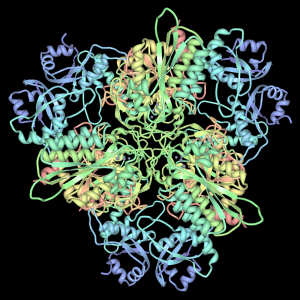
leucine aminopeptidase [Burley1992]
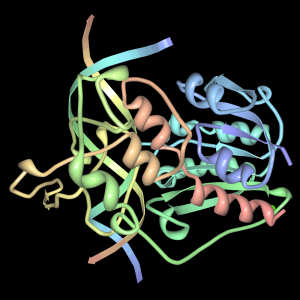
HaeIII methyltransferase / DNA [Reinisch1995]
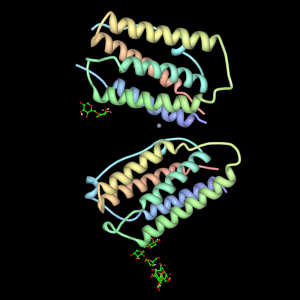
human interferon beta [Karpusas1997]
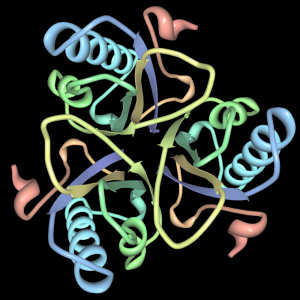
chorismate mutase [Strater1997]
.. that I judged this phase of Bill's career to be not merely the equal of that of a distinguished MD, Ph.D. researcher, but, because of the historical significance of his first two large structures, the career of a pioneering research physician.
Finally, I repeated to Bill his statement that his father may not have fully forgiven him for becoming something other than a medical doctor. Two things now stood opposed. They suggest several conclusions, among which one stands out.
Perhaps by way of reply, as I left for my home later that day, Bill shook my hand more firmly and longer than on any other day that I can recall.
But for now in my father's house I had stopped talking for in the Lipscomb way one states the facts, and the conclusion is self evident.
Notes
[1] And perhaps I should have added RNase A, RNase S, and chymotrypsin in a 4-way tie in 1967 with carboxypeptidase A as the third protein structure determined. Ribonuclease S may have some claim too, but at less than atomic resolution.
[2] Metabasis Therapeutics, Inc. is now Ligand Pharmaceuticals after aquisition in 2010.
[3] I neglected to mention the structural determination of the anti-cancer drug Vincristine. Moncrief, J. W. and Lipscomb, W. N., "Structures of Leurocristine (Vincristine) and Vincaleukoblastine. X-ray Analysis of Leurocristine Methiodide," J. Am. Chem. Soc. 87, 4963 (1965).
References
[Lipscomb1968] Lipscomb WN, Hartsuck JA, Reeke GN, Jr, Quiocho FA, Bethge PH, Ludwig ML, Steitz TA, Muirhead H, Coppola JC. The structure of carboxypeptidase A. VII. The 2.0-angstrom resolution studies of the enzyme and of its complex with glycyltyrosine, and mechanistic deductions. Brookhaven Symp Biol. 1968 Jun; 21(1):24\9690.
[Honzatko1983] Honzatko, R. B., Crawford, J. L., Monaco, H. L., Ladner, J. E., Edwards, B. F. P., Evans, D. R., Warren, S. G., Wiley, D. C., Ladner, R. C., & Lipscomb, W. N., "Crystal and molecular structures of native and CTP-liganded aspartate carbamoyltransferase from Escherichia coli," J Mol. Biol. 160, 219-263 (1983).
[Ke1989] Ke, H., Thorpe, C. M., Seaton, B. A., Lipscomb, W. N., & Marcus, F., "Structure Refinement of Fructose-1,6-bisphosphatase and its Fructose-2,6-bisphosphate Complex at 2.8 A Resolution," J Mol. Biol. 212, 513-539 (1989).++++
[Erion2005] Erion MD, van Poelje PD, Dang Q, Kasibhatla SR, Potter SC, Reddy MR, Reddy KR, Jiang T, Lipscomb WN. MB06322 (CS-917): A potent and selective inhibitor of fructose 1,6-bisphosphatase for controlling gluconeogenesis in type 2 diabetes. Proc Natl Acad Sci U S A. 2005 May 31;102(22):7970-5 (PubMed)
[Burley1992] Burley, S. K., David, P. R., Sweet, R. M., Taylor, A., & Lipscomb, W. N., "Structure Determination and Refinement of Bovine Lens Leucine Aminopeptidase and its Complex with Bestatin," J Mol. Biol. 224, 113-140 (1992).
[Reinisch1995] Reinisch, K. M., Chen, L., Verdine, G. L., and Lipscomb, W. N., The crystal structure of the Hae III methyltransferase covalently complexed to DNA: An extrahelical cytosine and rearranged base pairing, Cell 82, 143-153 (1995).
[Karpusas1997] Karpusas, M., Nolte, M., Benton, C. B., Meier, W., and Lipscomb, W. N., The crystal structure of human interferon beta at 2.2-A resolution, Proc. Natl. Acad. Sci. USA 94, 11813-11818 (1997).
[Strater1997] Strater, N., Schnappauf G., Braus, G. and Lipscomb, W.N., Mechanisms of catalysis and allosteric regulation of yeast chorismate mutase from crystal structures, Structure 5, 1437-1452 (1997).
Image credits
William Lipscomb: From his collection, reprinted on this website with permission from William Lipscomb.
Large-molecule images with black backgrounds: by James Lipscomb using the data from Protein Data Bank and rendered using the PDB Simple Viewer.
An early version of this web page is published under the terms of the Creative Commons copyright below in the book, The Selected Papers of William N Lipscomb Jr.: A Legacy in Structure-Function Relationships.
-- Apr. 2011, last updated November 2020,
Home page https://wlipscomb.tripod.com/
Work on this page (text) is by http://wlipscomb.tripod.com and is licensed under a Creative Commons Attribution 3.0 Unported License. You are free to copy, distribute, transmit, and modify the work for both commercial and non-commercial uses. You must attribute the work to website http://wlipscomb.tripod.com